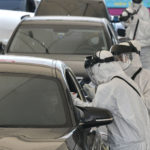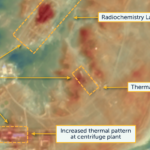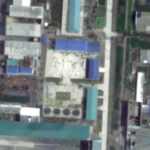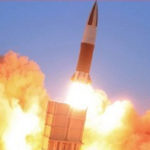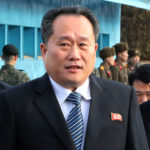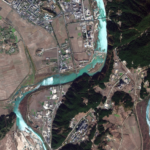August 9, 2021, by Victor Cha and Dana Kim—
To document the trajectory of South Korea’s national response efforts against the spread of COVID-19, the CSIS Korea Chair created a timeline of events outlining policies and other measures implemented to date... This timeline was originally published on CSIS. South Korea saw its first confirmed COVID-19 case…
April 15, 2021, by Joseph S. Bermudez Jr., Victor Cha, Andy Dinville and Dana Kim—
Recently acquired LANDSAT 7 and 8 thermal infrared imagery of the Yongbyon Nuclear Research Center provide strong indications that during March and April 2021, activity involving the heating of buildings and operations of facility support systems had resumed at several locations.
These indications reveal clear patterns, distinct from the surrounding terrain and daily solar heating patterns, that suggest that the Radiochemistry Laboratory, its associated thermal plant, and the centrifuge plant resumed operations during the early part of March 2021 and have continued into mid-April 2021.
March 26, 2021, by Joseph S. Bermudez Jr., Victor Cha and Dana Kim—
Commercial satellite imagery collected during the past eight months indicates that despite the absence of any nuclear testing by North Korea since 2017, the Pyongsan Uranium Concentrate Plant remains operational, is producing uranium concentrate (U3O8, “yellowcake”), and continues to be updated. Yellowcake can be enriched to become highly enriched uranium (HEU), which can be used to produce nuclear weapons.
December 24, 2020, by Joseph S. Bermudez Jr., Victor Cha and Dana Kim—
Located approximately 52 kilometers north of the DMZ and 125 kilometers north of Seoul, the Kal-gol missile operating base is one of the most developed of North Korea’s approximately 15-20 undeclared ballistic missile facilities. This base likely houses a reinforced brigade-sized unit equipped with 500-kilometer-range Hwasong-6 (Scud C) short-range ballistic missiles (SRBM) or Hwasong-9 (Scud-ER) medium-range ballistic missiles (MRBM).
September 8, 2020, by Joseph S. Bermudez Jr. and Dana Kim—
The Hungnam Fertilizer Complex has long been associated with producing chemical feed stocks or agents for North Korea’s nuclear weapons, chemical weapons and ballistic missile programs. Any modernization or improvement in its production capacities warrant close monitoring as they have the potential to support or augment WMD capabilities.
March 23, 2020, by Victor Cha and Dana Kim—
On March 21, 2020 North Korea launched two projectiles from Sonchon county in North Pyongan province towards the East Sea. The launches took place 5 minutes apart at 6:45am and 6:50am KST, respectively. The projectiles traveled a distance of 410km (255 miles) at a maximum altitude of 50km (31 miles) and closely resemble the KN-24 short-range ballistic missile system. This is the third event of Q1 in 2020, which is equivalent to the number of missile provocations in Q1 of 2017 during the “Fire and Fury” era.
March 2, 2020, by Victor Cha and Dana Kim—
On March 2, 2020 at 12:37pm (KST), North Korea launched two short-range projectiles from the Wonsan, Kangwon Province area towards the East Sea. The projectiles traveled a distance of 240km (150 miles) at a maximum altitude of 35km (22 miles) with a 20-second interval between the two launches. While the exact type and model of the projectiles are yet to be confirmed, considering the nature of the test they may be SRBMs or new surface-to-surface missiles. The short interval time also indicates that the event may have been a multiple rocket launcher system test.
January 22, 2020, by Victor Cha and Dana Kim—
Ri Son-gwon is the newly appointed Minister of Foreign Affairs of North Korea. He is a former military official in the Korean People’s Army (KPA) and the former head of North Korea’s Committee for the Peaceful Reunification of the Country (CPRC), the bureau in charge of inter-Korean relations.
November 14, 2019, by Joseph S. Bermudez Jr., Victor Cha and Dana Kim—
Recent satellite imagery from November 2019 shows the presence of four specialized railcars that have been associated with the movement of radioactive material in the past. The last observed movement of these railcars by Beyond Parallel was in April 2019. It is unclear whether the railcars are being used for the outbound shipment of irradiated liquid or solid waste, disassembled but contaminated equipment or the movement of fissile material to facilities outside the Yongbyon area. A less likely alternative is the inbound shipment of radioactive material from a facility outside the Yongbyon area.
October 9, 2019, by Joseph S. Bermudez Jr., Victor Cha and Dana Kim—
The October 2, 2019 Pukguksong-3 submarine-launched ballistic missile (SLBM) test launch has raised concerns over the forthcoming launch of North Korea’s first true ballistic missile submarine (SSB) as described in the Beyond Parallel Snapshot, which was published the same day.
